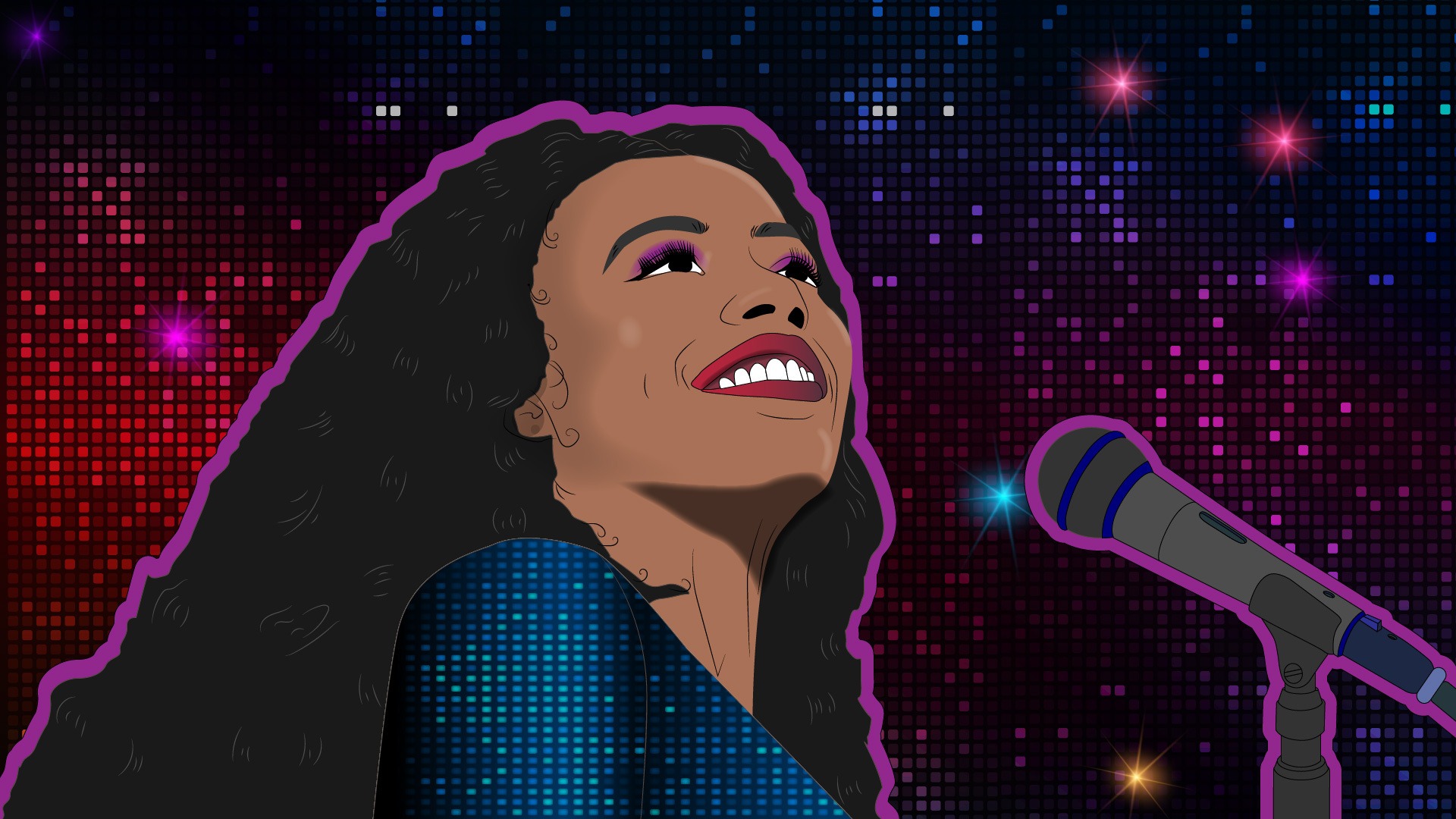What comes to mind when you hear disco? There are of course the show-stopping looks – Big hair! Sequins! Velvet! – and the consistent rhythm, dancing basslines, orchestral arrangements, synths, horns, and brass. And while we may have exited the golden age of disco after the late 70s, the infectiousness of the era’s hit songs – from Gloria Gaynor’s “I Will Survive” to Earth Wind and Fire’s “September” – remains unparalleled nearly 50 years after their releases. Why so?
Feeling good, looking good, sounding good
Turns out that disco is just really good music. “That’s why we’re still sampling it. It’s not surface level; it has dimension, it’s thoughtful,” points out singer Tanja Nachtigall. As a matter of fact, disco songs make some great covers, seamlessly lending themselves to different styles and contemporary interpretation. “Put the disco coefficient on any genre – it will slap. Take any disco song and strip it down – it will slap,” says Tanja, singing member of Montreal-based Grüv.
Growing up in Winnipeg in a musical family, disco called from inside the house. Her grandfather and great-uncle were all about it. “They wore platform boots, purple suits, thin little mustaches looking all slick,” she recalls of her elders, who came to Winnipeg by way of London, and originally from Jamaica. As a child, Tanja would try on their size 12 platform boots, only to fill their big shoes decades later as a disco singer. In 2010, she moved to Montreal to study jazz and has been pursuing it ever since. One day, a fellow member of the Montreal Gospel choir popped the big question, thinking she’d be perfect for the job: would she be interested in joining a disco band? “I was made for this. This is my calling,” states the artist who joined Grüv in 2016.
Tanja is one of 3 singers in the 10-piece band, which was formed by musicians and friends who were looking to put together something fun. “Newsflash, people love disco,” declares Tanja, and one show turned into many more, thereby transforming them into a serious performing band. Presenting disco songs originating between 1972 and 1979, Grüv will get any party going – including ones by Cirque du Soleil, who have hired them for a staff party. “Anytime people are looking to have levity and brightness and fun and light-heartedness, we are there. And that’s the thing with disco, there is no way you can stay in your chair.”
It’s the energy that gets you on your feet. Grüv will have you dancing and singing along the entire night, and get you to subscribe to the gospel of disco. “If, as a musician of any genre, you’re ever playing outside of your authenticity, everyone will hear it,” says Tanja. In order to sound good, the band rehearses quite a bit even if they are playing the same music. And their practices can be as much of a party as their concerts are. “You need to be in touch with each other and be fully present. Anything that’s distracting you from being in the present moment is going to be a drag. Disco is all about like, I’m looking at you. You’re looking at me. We’re having the best time.’’
It’s even more impressive to see and hear it happen on stage, where it is no small feat to fit 10 people and their instruments. “In a perfect world, we would have our own sound person for every show. You need somebody who understands your profile, rather than like inventing your sound profile at every show. It’s a long process,’’ the musician expresses.
Disco is serious business
“Disco is a bedrock artform, and one of the greatest culminations of modern music,” attests the singer. The music genre was a meeting place of showmanship and artistry, deeply rooted in musical innovation. “By innovation, we mean doing everything good from the past, and also trying new things that hit us. You’re right at that edge,” explains Tanja. And disco’s edge is one that can be felt in the music and quite literally in the vibes. “Disco has no boundaries. You’re a consumer and you’re a player in this game, you’re dancing while you’re singing. You have DJs intermixing with acoustic musicians, you have full orchestras playing disco, you have solo DJs, you have five tops, four tops, three tops, and duos.”
The performing artist’s job is to keep the rhythm going. The stakes are high, because if they don’t, if a musician’s solo is too long, the dance floor will break. “It’s a feedback loop where the artists are accountable to the audience, and the audience is accountable to the artists. And when they both deliver, it’s intoxicating.”
The music genre and culture welcomes everyone regardless of race, gender, and class. Here’s how Tanja puts it: “There are no snobs in disco! We’re here to have a good time, to sound good, to move our bodies. It’s about what gets me around the people who want to feel how I want to feel, not who look like me.” It becomes a celebration of self, for performers and the audience alike. On stage, Grüv dresses the part, and also lets it all hang out – it’s part of the spirit of disco, to come as you are, and be free. “Be your best self, celebrate it and celebrate everyone else. That’s how you get good vibes. Where else are you doing that in society?”
In that spirit, disco is the people’s music. In real life, Grüv members are normal people – they are engineers, dads, yoga teachers. Same goes for their audience, who show up to let loose. “Who has left a disco show feeling worse than they got in?” Tanja says. She points out the misconception that disco does away with the harshness of reality, but also reminds us that disco came about during race riots in the U.S. “Disco has the audacity to still be bright, happy and interracial and non-gendered. Where does that leave us in 2024? I think disco was ahead of its time in that respect, transcending the difficulties of now, so that I’m more resourced to face the demands of my everyday life.’’
A very special place
Studio 54 was famously the headquarters of disco. But did you know about Lime Light, the legendary Montreal discotheque that pre-dated Studio 54? It remained the biggest disco club in Canada from its opening in 1973 until its closure in 1980, setting the standard for ambiance, sound, and mixing. Montreal was no less than the world’s second disco hub. This has even been reflected in movies: Funkytown was based on Lime Light, which is fictionalized in the story. “Grace Jones was partying, James Brown was doing two shows a night, five nights in a row. You had not only local legends popping up, you had out-of-towners coming to the party.” Locals include Martin Stevens, known for the hugely popular song “Love is in the Air”, Robert Ouimet, godfather of disco and head DJ at Lime Light, and disco stars Denis LePage and his wife Denyse.
While still alive and thriving, it now requires a bit of searching to find disco in the city, but events do regularly pop up for Montrealers. And the legends are still active. “Alma Faye Brooks is still out here front-lining, singing, doing the damn thing,” highlights Tanja. Until she passed in 2022, Geraldine Hunt, known for her chart-topping single “Can’t Fake the Feeling” was still performing. “It’s like we forgot, but the world didn’t.”
“I think not having a hub like Lime Light as part of Montreal’s foundational dance scene is tragic,” laments the artist. “And dance music is more minimalist, which is cool. But there’s a time and a place where we should be dancing to an orchestra of people playing bangers.”
The city’s disco roots now translate to R&B and jazz scenes, with powerhouses like Kim Richardson and Michelle Sweeney. Artists like Ranee Lee, Malika Tirolien, and Dawn Tyler Watson keep the spirit of disco music going in this city today. Now, time to give disco its proper tribute and invest in this catchy music that brings people together.
Don’t miss our profile on house music and BLK PRL.
Written by Christelle Saint-Julien
Illustration by Holly Li





















